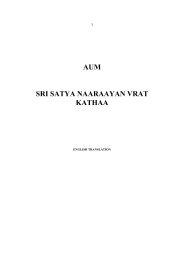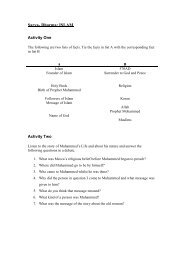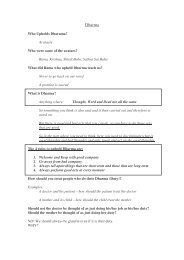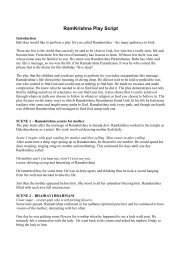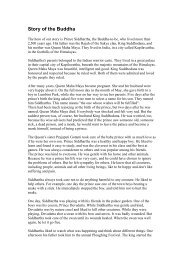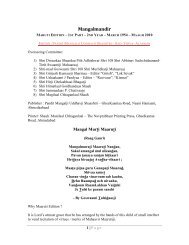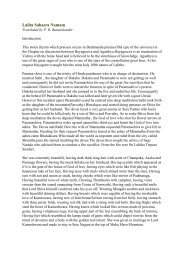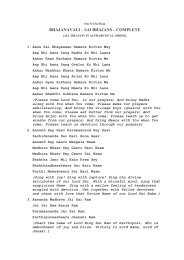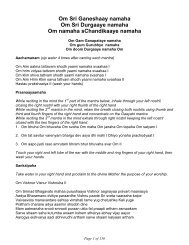Ahimsa Worksheet
Ahimsa Worksheet
Ahimsa Worksheet
Create successful ePaper yourself
Turn your PDF publications into a flip-book with our unique Google optimized e-Paper software.
Balvikas <strong>Worksheet</strong><br />
Lessons in Human Values: <strong>Ahimsa</strong> (Non-violence)<br />
Help Ever, Hurt Never - Baba<br />
Quotes from Gandhi<br />
Literally speaking, ahimsa means nonviolence.<br />
But to me it has much higher,<br />
infinitely higher meaning. It means that<br />
you may not offend anybody; you may<br />
not harbour uncharitable thought, even in<br />
connection with those who consider your<br />
enemies. To one who follows this<br />
doctrine, there are no enemies. A man<br />
who believes in the efficacy of this<br />
doctrine finds in the ultimate stage, when<br />
he is about to reach the goal, the whole<br />
world at his feet. If you express your<br />
love- <strong>Ahimsa</strong>-in such a manner that it<br />
impresses itself indelibly upon your so<br />
called enemy, he must return that love.<br />
This doctrine tells us that we may guard<br />
the honour of those under our charge by<br />
delivering our own lives into the hands of<br />
the man who would commit the sacrilege. And that requires far greater courage than<br />
delivering of blows.<br />
My non-violence does not admit of running away from danger and leaving dear ones<br />
unprotected. Between violence and cowardly flight, I can only prefer violence to<br />
cowardice. I can no more preach non-violence to a coward than I can tempt a blind<br />
man to enjoy healthy scenes.<br />
Non-violence is a power which can be wielded equally by all - children, young men<br />
and women or grown-up people, provided they have a living faith in the God of Love<br />
and have therefore equal love for all mankind. When non-violence is accepted as the<br />
law of life, it must pervade the whole being and not be applied to isolated acts.<br />
Write here what you think are the key characteristics of ahimsa
Cowardice and Love<br />
The British once ruled India. In order to maintain their rule they carried out many<br />
cruel practices on Indians. The British enforced their rule through actions such as a<br />
massacre of Indians, numerous beatings with clubs at the salt works, numerous<br />
arrests of Indians whether they were guilty of a crime or not and general<br />
interruptions of Indian events. Once Gandhiji led a march against the British in<br />
protest of their rule. The British however wanted to put a stop to this. They marched<br />
against Gandhiji and his followers. Some people became frightened at the site of<br />
horses galloping towards them. Gandhiji remained calm. Anybody else might have<br />
suggested that either they fight the British using violence or run away like cowards.<br />
Gandhi however knew better. He knew that the British were people too and it would<br />
be wrong to harm them. At the same time he would not be a coward and run away.<br />
They had come to protest against the rule of the British government, they should do<br />
their duty and continue and not run away like cowards. Instead Gandhi knew that<br />
horses would not trample over still bodies lying down, And so, even though they<br />
were scared of the horses that were hurtling towards them at great speed the people<br />
lay down on the floor. On and on the horses ran. They seemed like they would never<br />
stop. But the people lay still on the ground. The horses were now approaching and<br />
came closer and closer. Until, they stopped. Sure enough the horses stopped. The<br />
British were dismayed at the display of courage and had to retreat. This story shows<br />
that ahimsa is about doing everything you can to avoid violence, but will never mean<br />
that you have to become a coward in the face of trouble.<br />
What is the key lesson to be learnt from this story?<br />
Jainism <strong>Ahimsa</strong><br />
Jivadaya (Respect for all Living<br />
Forms) and <strong>Ahimsa</strong> (non-violence)<br />
are the fundamental principles of<br />
Jainism.<br />
Jainism, a religion and philosophy<br />
of India, is one of the most ancient<br />
religions of India and of the world.<br />
The Jain observe non-violence<br />
(<strong>Ahimsa</strong>) to all forms of life<br />
regardless of their shape or form.<br />
The Jain strive to be non-violent in<br />
thought, action, and deed, taking<br />
care not to directly or indirectly<br />
harm any living beings.
Vegetarianism, compassion and respect for all living creatures are at the<br />
heart of the Jain way of life.<br />
Imagine the world if everyone put such thoughtfulness into their daily lives.<br />
In Shree Chitrabhanu's words, "the universe is not for man alone. It is a field<br />
of evolution for all of life's forms. Jainism teaches that life is life, not only in<br />
people of all lands, colours, and beliefs, but is of the same sacred quality in all<br />
creatures, right down to the tiny ant and humble worm. Consciousness exists<br />
in everything which grows, regardless of the size of its form. Though different<br />
forms are not the same in mental capacity and sensory apparatus, the life force<br />
is equally worthy in all."<br />
Take some notes from what your teacher is going to tell you about who ahimsa applies to.




